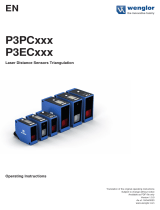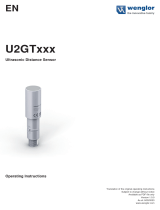Page is loading ...

Operating instructions.
OM70 laser point / laser line tolerance
sensors

en_BA_OM70_point_line_tolerance.docx 2/46 Baumer Electric AG
6/16/2020 9:58 AM/tof V1.0 ANW_81269262 Frauenfeld, Switzerland
Contents
1 General information ...................................................................................................................... 3
1.1 Concerning the contents of this document ..................................................................................... 3
1.2 Intended use ................................................................................................................................... 3
1.3 Safety .............................................................................................................................................. 4
2 Quick start-up guide ..................................................................................................................... 5
3 Mounting and connections .......................................................................................................... 7
3.1 Dimensions ..................................................................................................................................... 7
3.1 Sensor reference levels .................................................................................................................. 8
3.2 Definition of the measuring range ................................................................................................... 9
3.3 Mounting ....................................................................................................................................... 12
3.4 Alignment ...................................................................................................................................... 13
3.5 Connection .................................................................................................................................... 16
4 Configuration .............................................................................................................................. 18
4.1 Overview of control elements ....................................................................................................... 18
4.2 Function tree ................................................................................................................................. 21
4.3 LIVE MONITOR ............................................................................................................................ 22
4.4 REF. DIST ..................................................................................................................................... 23
4.5 PRECISION .................................................................................................................................. 25
4.6 ANALOG OUT .............................................................................................................................. 27
4.7 DIGITAL OUT ................................................................................................................................ 29
4.8 SYSTEM ....................................................................................................................................... 32
4.9 SETTING ...................................................................................................................................... 35
4.10 Configuration using the RS-485 interface ..................................................................................... 36
5 Operation ..................................................................................................................................... 37
5.1 Measuring frequency, measuring repeat time and response time ................................................ 37
5.2 Alarm output .................................................................................................................................. 37
5.3 Influence of ambient light .............................................................................................................. 38
5.4 Error correction and tips ............................................................................................................... 38
6 Safety instructions and maintenance ....................................................................................... 39
6.1 General safety instructions ........................................................................................................... 39
6.2 Sensor inscriptions ....................................................................................................................... 40
6.3 Front optic ..................................................................................................................................... 41
6.4 Cleaning the sensors .................................................................................................................... 41
6.5 Disposal ........................................................................................................................................ 41
7 Sensor data sheet ....................................................................................................................... 42
8 Revision history .......................................................................................................................... 45

en_BA_OM70_point_line_tolerance.docx 3/46 Baumer Electric AG
6/16/2020 9:58 AM/tof V1.0 ANW_81269262 Frauenfeld, Switzerland
1 General information
1.1 Concerning the contents of this document
This manual contains information about the installation and initial setup of Baumer OM70 laser point / laser
line sensors.
It is a supplement to the mounting instructions supplied with each sensor.
1.2 Intended use
The Baumer OM70 laser point / laser line sensor measures tolerances in relation to a taught reference. It was
specially developed for easy handling, flexible use, and highly accurate measurement.
1.2.1 Functional principle of triangulation
In the triangulation principle, the sensor transmits a light point or light beam to the object to be measured, and
the reflected light strikes a receiver line in the sensor at a special angle. Depending on the distance, the angle
of incidence changes and thus so does the position of the light spot or light beam on the receiver. The micro-
controller allows the suppression of interfering reflections, thus providing reliable data even on critical
surfaces.
Read these operating instructions carefully and follow the safety instructions!
Near
Far

en_BA_OM70_point_line_tolerance.docx 4/46 Baumer Electric AG
6/16/2020 9:58 AM/tof V1.0 ANW_81269262 Frauenfeld, Switzerland
1.2.2 Laser point or laser line
OM70 laser point OM70 laser line
For small objects, if accurate positioning of the laser
point is important, or for sharp transitions, a sensor
with a laser point is suitable.
Stable measurements on rough surfaces and
textured color surfaces thanks to a fine laser line < 10
mm
1.3 Safety
NOTE
Provides helpful operation instructions or other general recommendations.
CAUTION!
Indicates a potentially hazardous situation. Avoid these situations in order to
prevent any personal injury or damage to the device.

en_BA_OM70_point_line_tolerance.docx 5/46 Baumer Electric AG
6/16/2020 9:58 AM/tof V1.0 ANW_81269262 Frauenfeld, Switzerland
2 Quick start-up guide
After connection and installation, the sensor is configured using the display. The sensor is then ready for
operation and shows the measured value in mm on the screen. Optionally, the analog output can also be
limited or the switching output configured.
Connection
Installation
Application-specific settings
Let's get started
Connection
Connect the sensor according to the connection
diagram. A shielded connection cable (8-pole M12)
must be used.
When everything is correctly connected, the sensor
starts up.
Key functions
ESC = Back
ESC 2 sec. = Run mode
UP = Up/increase value
DOWN = Down/decrease value
SET = OK
SET 2 sec. = Save value
Slide over all 4 keys:
----> = Enable the panel if locked
<---- = Jump to run mode
Setting the language
The language is selected and confirmed by pressing
SET for 2 seconds.
English
Deutsch
Italiano
Français
7
6
1
2
5
4
3
8
1
1
2
4
LANGUAGE
English
3

en_BA_OM70_point_line_tolerance.docx 6/46 Baumer Electric AG
6/16/2020 9:58 AM/tof V1.0 ANW_81269262 Frauenfeld, Switzerland
Installation
For standard applications, the sensor is mounted and
aligned at right angles to the measuring axis. See
Alignment Chapter.
The object must be within the measuring range Mr,
i.e. between the start of the measuring range Sdc,
and the end of the measuring range Sde.
Application-specific settings
Teaching the reference
Everything is measured from this reference point. If the
object is closer to the sensor, the distance is given with a
negative value (-) in mm, and if the object further away, it is
given with a positive value (+).
Precision (filter)
To achieve better resolution, it is possible to alternate
between Standard, High ,Very High and Highest by filtering
the output values.
Analog Out
With SCALE OUT, the range can be restricted
symmetrically around the reference point, thus optimizing
the resolution and linearity of the analog output. For the
point near the sensor, 0V or 4 mA apply, and for the more
distant point 10V or 20mA. The voltage or current output is
also selected under ANALOG OUT. The characteristic
curve can also be inverted under CHARACTERISTIC.
Digital Out
The sensor has a switching output which can be configured
either symmetrically or asymmetrically from the reference
point under DIGITAL OUT.
The output level can also be inverted and the hysteresis set
here.
Let's get started
The sensor continuously shows the deviation (tolerance) in mm on the display and transmits it to the
controller using the analog output. Alternatively, the measuring value can also be retrieved from the RS-485
interface.
LIVE MONITOR
REF. DIST PLACE THE REFERENCE TEACH REF
PRECISON Standard
High
Very High
Highest
ANALOG OUT SCALE OUT RANGE
ANALOG OUT Current / Voltage
CHARACTERISTIC Pos. slope / Neg. slope
DIGITAL OUT DIGITAL OUT Symmetric / Asymmetric
TOLERANCE Value in mm
TOLERANCE NEAR Value in mm
TOLERANCE FAR Value in mm
OUTPUT LEVEL Active high / Active low
HYSTERESIS Value in mm
SYSTEM TRIGGER MODE Continuous/Single shot
RS485 BAUD 38400
57600
115200
230400
460800
921600
1500000
RS485 ADDR number
SENSOR INFO SENSOR TYPE
SERIAL NUM
LANGUAGE English
Deutsch
Inglese
Français
RESET Factory Set
SETTINGS APPLY Setting 1
Setting 2
Setting 3
STORE Setting 1
Setting 2
Setting 3
SHOW ACTIVE Values
SHOW SETTING 1 Values
SHOW SETTING 2 Values
SHOW SETTING 3 Values
2
4
3
Blind region
End of
measuring range
Sde
Sensor reference
point
Start of
measuring range
Sdc
Object
Measuring range
Mr
Reference
(taught)
Object
Tolerance
far
Tolerance
near
Range
Range
4 mA / 0 V
20 mA / 10 V
12 mA / 5 V

en_BA_OM70_point_line_tolerance.docx 7/46 Baumer Electric AG
6/16/2020 9:58 AM/tof V1.0 ANW_81269262 Frauenfeld, Switzerland
3 Mounting and connections
3.1 Dimensions
*Optical axis
5
74
85
26
M12 x 1
7
64
9
9
50
4,5 2
55
LED
4,3
19
14
CAUTION!
Connection, installation and commissioning may only be performed by qualified
personnel. Protect optical surfaces from moisture and dirt.

en_BA_OM70_point_line_tolerance.docx 8/46 Baumer Electric AG
6/16/2020 9:58 AM/tof V1.0 ANW_81269262 Frauenfeld, Switzerland
3.1 Sensor reference levels
The sensor can be aligned by the following surfaces:
The laser beam of the sensor runs parallel ( // ) to level R3 and is at a right angle to levels R1 and R2. Levels
R1, R2, and R3 serve as a reference for sensor alignment during installation.
19 mm
Level R3
Laser
beam
Level R1
Level R2
13 mm
50.5 mm

en_BA_OM70_point_line_tolerance.docx 9/46 Baumer Electric AG
6/16/2020 9:58 AM/tof V1.0 ANW_81269262 Frauenfeld, Switzerland
3.2 Definition of the measuring range
The sensor measures distances within the measuring range. The important definitions are described in the
following figure. The reference level R2 applies as a reference for 0.
3.2.1 Blind region
The area from the reference level R2 up to the start of measuring range Sdc is called the blind region, the
sensor cannot detect any objects there.
If there are any objects in this region, this can lead to incorrect measured values.
NOTE
See chapter ANALOG OUT for further information on the analog output.
Measuring range Mr
End of measuring
range Sde
Start of measuring
range Sdc
R2
Object
Blind region

en_BA_OM70_point_line_tolerance.docx 10/46 Baumer Electric AG
6/16/2020 9:58 AM/tof V1.0 ANW_81269262 Frauenfeld, Switzerland
3.2.2 Transmitter and receiver axis
The transmitter and receiver axes must not be covered by obstacles, since this could adversely affect precise
measurements.
Laser beam
Measuring range Mr
Receiver axis:
Prohibited area for
obstacles
End of measuring
range Sde
Start of measuring
range Sdc
19 mm
L1
L2
13 mm
Prohibited area for
obstacles
Receiver: Width 14 mm
around the central axis
of the sensor
Max. laser beam diameter (see
data sheet)
Transmitter axis
Dimensions L1 and L2, see
receiver position according to
Sensor Data Sheet chapter.
14 mm

en_BA_OM70_point_line_tolerance.docx 11/46 Baumer Electric AG
6/16/2020 9:58 AM/tof V1.0 ANW_81269262 Frauenfeld, Switzerland
3.2.3 qTarget
The field of view is aligned with the housing reference surfaces at the factory. The beam position is in the
same place for every sensor, which simplifies planning and sensor replacement.

en_BA_OM70_point_line_tolerance.docx 12/46 Baumer Electric AG
6/16/2020 9:58 AM/tof V1.0 ANW_81269262 Frauenfeld, Switzerland
3.3 Mounting
The sensor has four mounting holes for flexible alignment and mounting. The use of 2 M4x35 screws as well
as suitable washers is recommended for mounting. The tightening torque is max. 1.2 Nm.
3.3.1 Mounting kit for standard installation Order no. 11120705
With the mounting bracket for standard installation, the sensor can be mounted quickly and easily at a 90°
angle to the reference surface.
Tightening torque
max. = 1.2 Nm
Mounting kit 11120705
Contents of this set:
- 90° mounting bracket
- Threaded plate
- 2x spherical head screw M4x35 Torx
- 1x Torx tool T20
66 mm
28.5 mm

en_BA_OM70_point_line_tolerance.docx 13/46 Baumer Electric AG
6/16/2020 9:58 AM/tof V1.0 ANW_81269262 Frauenfeld, Switzerland
3.4 Alignment
To achieve as reliable and exact measured values as possible, the following hints and tips for mounting should
be followed.
3.4.1 Steps / edges
If measurements are carried out directly beside steps/edges, make sure that the reception beam is not
covered by the step/edge. The same applies when the depth of holes and cracks is measured.
3.4.2 Shiny surfaces
With shiny surfaces, it is important to ensure that the direct reflection does not strike the receiver. This can be
prevented by tilting the sensor slightly. To check this, place a sheet of white paper on the disc of the receiver;
the direct reflection can then be seen clearly.
3.4.3 Round, shiny surfaces
With round, shiny surfaces, the sensor should be aligned in the same axis as the round object in order to
avoid reflections.

en_BA_OM70_point_line_tolerance.docx 14/46 Baumer Electric AG
6/16/2020 9:58 AM/tof V1.0 ANW_81269262 Frauenfeld, Switzerland
3.4.4 Shiny objects with evenly aligned structure
Particularly with shiny objects, for example turned parts, ground surfaces, extruded surfaces and the like, the
installation position affects the measuring result.
3.4.5 Objects with evenly aligned colored edges
In the correct orientation, the influence on the measuring accuracy is low. In the wrong orientation, the
deviations depend on the differences in reflectivity of the various colors.
3.4.6 Moving objects
If the contour of an object is measured, it is important to ensure that the object moves at right angles to the
sensor, to avoid shadowing and reflections on the receiver.

en_BA_OM70_point_line_tolerance.docx 15/46 Baumer Electric AG
6/16/2020 9:58 AM/tof V1.0 ANW_81269262 Frauenfeld, Switzerland
3.4.7 Protection from ambient light
When installing optical sensors, it is important to ensure that there is no strong ambient light in the area of
detection of the receiver.
3.4.8 Reciprocal influence
If several optical sensors are used, they may mutually influence one another. During installation, ensure that
only the sensor's own laser spot is in the detection range of the receiver. Up to a measuring range of 600 mm,
the sensors can be lined up in a row without them influencing each other (picture in the middle).
If the mutual interference cannot be avoided through installation, the sensors can be operated asynchronously
using the Sync-In input, see chapter TRIGGER MODE.

en_BA_OM70_point_line_tolerance.docx 16/46 Baumer Electric AG
6/16/2020 9:58 AM/tof V1.0 ANW_81269262 Frauenfeld, Switzerland
3.5 Connection
3.5.1 Pin assignment and connection diagram
7
6
1
2
5
4
3
8
Color
Function
Description
Pin 1
WH = white
Rx/Tx-
RS 485 receive/transmit- (B)
Pin 2
BN = brown
+ Vs
Voltage supply (+15…+28 VDC)
Pin 3
GN = green
analog
Analog output (4…20 mA or 0…10V)
Pin 4
YE = yellow
out
Switching output, push-pull
Pin 5
GY = gray
alarm
Alarm output, push-pull
Pin 6
PK = pink
Rx/Tx+
RS-485 receive/transmit+ (A)
Pin 7
BU = blue
0V
Ground GND
Pin 8
RD = red
sync in
Input synchronization
CAUTION!
Products with laser class 1 laser beams in accordance with EN 60825-1:2014
can be operated safely without additional safety precautions. Nevertheless
direct contact between the eye and beam should be avoided.
CAUTION!
The IP protection class is valid only if all connections are connected as
described in the technical documentation.
CAUTION!
Connection, installation and commissioning may only be performed by qualified
personnel.
CAUTION!
Incorrect supply voltage will destroy the device!
NOTE
We recommend that you connect unused cables to GND (0V).
Top view of plug

en_BA_OM70_point_line_tolerance.docx 17/46 Baumer Electric AG
6/16/2020 9:58 AM/tof V1.0 ANW_81269262 Frauenfeld, Switzerland
3.5.2 Connection cable
An 8-pole, shielded connection cable (connector) is required.
Baumer connection cables with the following order codes are recommended:
10127844 ESG 34FH0200G (length 2 m, straight plug)
11053961 ESW 33FH0200G (length 2 m, angled plug)
10129333 ESG 34FH1000G (length10 m, straight plug)
10170054 ESW 33FH1000G (length 10 m, angled plug)
Other cable lengths are available.
When the analog output is used, the cable length affects signal noise. Signal noise increases the longer the
connection cable is.
Analog output I_OUT
Noise: 5.92 µA (1 sigma) (10m cable and 680 ohms)
3.59 µA (1 sigma) (2m cable and 680 ohms)
Analog output U_OUT
Noise: 4.80 mV (1 sigma) (10m cable and 100 kOhms)
3.03 mV (1 sigma) (2m cable and 100 kOhms)
We recommend that you use the RS-485 interface for high-precision applications.

en_BA_OM70_point_line_tolerance.docx 18/46 Baumer Electric AG
6/16/2020 9:58 AM/tof V1.0 ANW_81269262 Frauenfeld, Switzerland
4 Configuration
4.1 Overview of control elements
4.1.1 Display modes
Run mode
The sensor is in run mode, the measuring value is
displayed in large characters.
Main menu
In the main menu the active mode is displayed at the top,
and the measuring value is displayed at the bottom.
Scroll bar
The square on the right indicates the position within the
current menu. The next menu item can be accessed using
the arrow keys.
Change value
If the function/mode at the top is highlighted in black, the
value of the lower line can be adjusted using the
UP/DOWN keys and saved with SET (hold).
Process successful
The display background lights up green: Value
successfully saved
Error
The display background lights up red: Error during the
save process or wrong value entered.
Setting mode
As soon as the sensor is in setup mode, the display
background lights up blue.
Keys locked
If this symbol is on the left side of the screen, the four
pushbuttons are locked for operation.
Warming up
The warm-up sign appears in the top right of the display.
The sensor is not yet in thermal equilibrium; optimum
measurement performance is reached after the symbol
disappears.
+12,422 mm
TOLERANCE
+12,422 mm
PRECISION
STANDARD
VERY HIGH
+12,422 mm
TOLERANCE
+12,422 mm
Graphical
display
LEDs
Touch panel: Four
touch-sensitive keys
ESC
UP
DOWN
SET
TOLERANCE
+12,422 mm
PRECISION

en_BA_OM70_point_line_tolerance.docx 19/46 Baumer Electric AG
6/16/2020 9:58 AM/tof V1.0 ANW_81269262 Frauenfeld, Switzerland
4.1.2 Functions of the individual keys
Key
Pressed briefly
Pressed >2 s.
ESC
Back
Jump to run mode
UP
Up/increase value
DOWN
Down/decrease value
SET
OK/submenu/next entry**
Save value*
*Only in setup mode menu when the top line is highlighted in black (change value)
**When entering strings of numbers, use OK to jump to the right. Once the end is reached, the cursor jumps
back to the left to the beginning
4.1.3 Locking the touch panel
The keys on the control panel are locked when they are not pressed for 5 minutes. A key symbol appears, and
the measuring value is displayed in large lettering.
When it is pressed, the following text appears:
To re-enable the touch panel, it is required to quickly slide a finger over all four keys from left to right (slide
over ESC, UP, DOWN, and SET).
When controlled via RS-485:
When the sensor is controlled using RS-485, it cannot be operated with the display at the same time. The
keys are disabled. When the keys are pressed, the following text appears on the display:
Disconnect briefly from the power supply or use an RS-485 command to enable the display and operate the
sensor using the display.
Locking using an RS-485 command:
The sensor keys can be permanently locked using an RS-485 command. This lock remains activated even if
the sensor is no longer controlled using RS-485. The keys must be unlocked with an RS-485 command. When
the locked keys are touched, the following text appears on the display:
RS-485 controls
the sensor
RS-485 locks
the touch keys

en_BA_OM70_point_line_tolerance.docx 20/46 Baumer Electric AG
6/16/2020 9:58 AM/tof V1.0 ANW_81269262 Frauenfeld, Switzerland
4.1.4 Further key functions
Action
Reaction
Slide over all keys from left to right
Unlock locked touch panel
Only if touch panel is locked
Slide over all keys from right to left
Jump directly to run mode
Can be used from any menu
4.1.5 LEDs on the sensor
LED
Lights up
Flashes
Yellow
out1 activated
Switching output1 active
-
Red
out2 activated
Alarm output active. No measuring object
within the field of measurement or signal
quality is inadequate.
Insufficient signal reserve
Object close to signal reserve or signal quality not
ideal
Green
Supply voltage
Sensor ready for operation.
Short circuit
Check connection at switch or alarm output.
TOLERANCE
+12,422 mm
/




